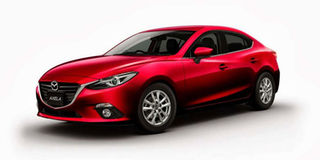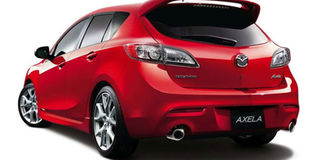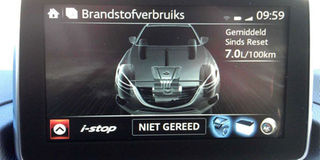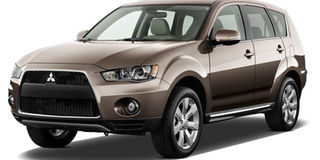Premium
‘Subtly sporty’ Axela an upgrade from Corolla

The Mazda Axela has a sprightly front-drive chassis and offers buttery tactile feedback that pleases both enthusiasts and the indifferent alike.
What you need to know:
- It is a good alternative to the Corolla and is definitely an upgrade, more so in the looks department which you also brought up.
- It drives really well and will stay stable well beyond 110km/h and all the way to its 180km/h cut-off, if sourced from Japan.
- Compared to the Impreza, the Mazda might ultimately be the better ride.
Dear Baraza,
I enjoy your articles very much and always look forward to Wednesdays. Is the Mazda Axela hatchback (1490-2000cc) a good car?
I have a 2004 Toyota NZE G Grade that I would like to dispose of and buy a locally used alternative and I think the Axela hatch is pretty. How does it drive and is it stable at over 110km? A locally used Subaru Impreza 2006-2007 is another possible alternative. Which is better of the two?
Another question: in my logbook the weight of the NZE is indicated as 670kg. Is this a mistake or is the car that light? Google shows that it should weigh at-least 1,000kg.
Hi there,
Yes, the Axela hatch is a good car to drive. It has a sprightly front-drive chassis and offers buttery tactile feedback that pleases both enthusiasts and the indifferent alike, while returning good economy figures for the wary (and weary) of pocket.
It is a good alternative to the Corolla and is definitely an upgrade, more so in the looks department which you also brought up. As already said, it drives really well and will stay stable well beyond 110km/h and all the way to its 180km/h cut-off, if sourced from Japan.
Compared to the Impreza, I will kick myself for saying this, but the Mazda might ultimately be the better ride. It really does feel good to drive: it is lively enough to ensure even the most mundane of runs is never boring but it is not too lively as to be a borderline race car, which is rarely a good thing in everyday life.

“Subtly sporty” would be a fairly accurate description for the Mazda Axela.
Time and again I have said there is no point in driving a Subaru if it is not turbocharged, and the Impreza falls squarely within the confines of this blanket condemnation.
The turboless Impreza feels comparatively stodgy, lumpen and lethargic if you know what real Subarus should feel like, and likened to the equally turboless Mazda, well... the Shizuoka cart doesn’t quite match the sensations occasioned by the pride of Hiroshima. Also, there has never been a pretty Impreza, while there is rarely ever an ugly Mazda.
Come to think of it, when last did we see an ugly Mazda since the badge-engineered 121 hatch from the early ‘90s, which was a Ford Fiesta anyway? The vehicle weight indicated on the logbook is erroneous.
I think there is a digit (a 1, probably) missing in front of the 6, which should be the GVW (gross vehicle weight: the weight of the vehicle when fully laden) since the tare weight of the Corolla is approximately 1,300kg; factoring in a 400kg load capacity brings the total sum to 1,700kg, which is pretty close to the 1670 I am guesstimating the wrong figure to supposedly be. I’m not really sure about my hypothesis, but what I’m sure of is the vehicle does not weigh 670kg, nor does it have a 670kg load capacity.
***
How exactly does an i-Stop system work?

Mazda’s i-Stop works a little differently in that the engine cut-off has to be at very precise points of piston travel and the pulse timing of the direct injection optimised to work in tandem with that cutoff.
I am an ardent reader of your column and appreciate the good work you do and the advice you give. I recently acquired a 2010 version of the Mazda Axela 2000cc with an i-Stop system. However, the system has been inactive and keeps flashing a yellow warning light on the dashboard.
I would like your advice on how to resolve this before I start denting my wallet with clueless mechanics. How does the i-Stop system work and can you recommend anyone locally who has the skills to activate it?
JM
Hi Jim! (Ha! I’ve always wanted to say that!) We have a heavily Mazda-centric theme going on today. So, we are back to the Axela.
Yea, that i-Stop system sounds really complicated by description so when it goes on the fritz, you might be looking at a pretty technical problem, and you are right; you cannot just hand over this kind of complexity to any Joe Spanner or Tony Wrench that is immediately available. You have to find a specialist.
Now, I have never driven a Mazda with the i-Stop feature, but I have driven other cars with the start-stop technology, and the general tendency is the system can be deactivated.
However, Mazda’s i-Stop works a little differently in that the engine cut-off has to be at very precise points of piston travel and the pulse timing of the direct injection optimised to work in tandem with that cutoff.
This sounds a lot more complicated than in the use of capacitors and batteries as applied in other cars, where engine restart is semi-conventional (via starter and/or flywheel) while Mazda’s i-Stop instead squirts fuel into the inactive engine and burns it, and the force of this initial pseudo-power stroke is what gets the engine turning. So, can the i-Stop be deactivated? This would be the first thing to do to prevent potentially catastrophic failures in the near future.
If it can be deactivated, then do so and the car remains usable without the need for repair, sort of like removing a thermostat or a trafficator. If you still want the fuel-saving magic anyway, or it cannot be deactivated, well then... let’s wait until someone who can handle this problem reads this column and reverts, and I will in turn get them in touch with you because as we speak, I do not know anyone who handles this kind of problem. CMC probably could, and would, but I hear stories about them...
***
My C and H gauge is playing up
Dear Mr Baraza,
I am a regular reader of your articles and to tell you the truth, I have learnt and understood the general running of a motor vehicle from them. I drive a Nissan Sunny. Recently, I noticed that something was wrong with the “C and H gauge” on the dashboard.
The pointer jumps to the middle of the gauge the moment I start the car. Sometimes, after I start the car, while the engine is still warming up for about five minutes or so, the pointer even tilts slightly further past the middle of the gauge.
Then again, from the middle of the gauge, the pointer suddenly drops to a position slightly higher than zero. Now, should I be very worried about this gauge? I am confused; please help me. Diana Minja
Hi Diana,
Your worry about the gauge should not be extreme. Yes, you should worry because it needs a fix but no, you shouldn’t worry too much because the fix is not exactly open-heart surgery. The temperature sensor in the engine is acting up and needs to be replaced, simple as that. If not, then probably the gubbins controlling the pointer in the instrument cluster could be acting up as well; perhaps via a loose electrical junction, which is again a simple fix to carry out.
***
Let’s talk about space, comfort, stability power and prestige

The Fielder Z is better than the Sienta and the Voxy.
Hi Baraza,
I intend to upgrade from the Mazda Demio I bought after you praised it enthusiastically. It has not let me down but now I need to upgrade to a car that is: 1. More spacious, 2. More comfortable 3. More stable on the road 4.
More powerful. 5. More prestigious. Which one would you pick from among the Fielder, Voxy and Sienta on the three on the above parameters and how does it feel to drive each of them? Compare the 2010 model for each. Sir Patrick
Hi Patrick,
I was about to suggest upgrading to the Axela another reader seems so enamoured of but I realised that you want to choose between a Fielder, a Voxy and a Sienta. What? No Axela? The Axela ticks all the 5 boxes but you don’t seem to want it. Are you sure you don’t want an Axela?
Anyway, there is nothing prestigious about a 2010 Sienta; if anything, it looks like a low-capacity public service vehicle. These are common on the Namanga and Oloitoktok roads, as well as certain parts of Central Kenya.
In terms of stature, you could call it a well-dressed Probox. Speaking of Toyota wagons... the Fielder barely scrapes its way out of the same puddle of shamefaced dearth of status. You could get a “prestigious” Fielder of sorts — and I’m using the term very liberally here — but this will specifically have to be the Fielder Z, which is the top trim of this estate.
It looks as stylish as you’d expect cheap mass-production to look; lesser trims reek of the disruptive desperation that is Uber and Taxify in an African city. Paint it yellow and your friends will enquire what cab service you have registered it to.
That leaves us with the Voxy. It is actually quite stylish for a van and doesn’t look half bad when done up properly, and therein lies the key to success. You have to do it up properly because the scope with which to get things tastelessly wrong is pretty wide.
Do not attach a spade to the back door or a snorkel to the front quarter panels: that is just pathetic, it is not prestigious. The Voxy is more spacious than the rest of the pack, could be more comfortable (at least for passengers it is) and more powerful but I cannot guarantee its “stability” on the road compared to that sexy little hatchback you are abandoning.
It might not drive as well as the Demio and I don’t really know what you need a seven-seat van for because your current five-seat supermini tells me passengers do not feature prominently in your driving existence.
Of the three cars I’d pick a Fielder and make it a Z. It drives better than both the Sienta and the Voxy, and... well the Sienta is just an embarrassing car to own if you won’t monetise that ownership and the Voxy is pointless if you don’t always have passengers. The Fielder wins by elimination rather than by subduing the rest.
*Note: in the motoring world, there is one word that can sum up all five parameters: spacious, comfortable, stable, powerful and prestigious. That word is “German”.
***
How reliable, well-put-together is the Mitsubishi Outlander?

Owning an Outlander might not be as satisfying as you imagine it to be.
Dear JM,
I am an ardent reader of your column – anything with an engine cannot escape my inquisitive eyes. I think you should talk a little bit about motorbikes—I am a rider too — but not of the Chinese and Indian death traps, though; I mean others.
Back to the subject matter, I have owned and driven several cars: a 2001 Toyota Prius, a 2005 Honda Accord, a 2006 Mazda Demio, a2006 Toyota Raum, a2008 Toyota Vanguard and a2009 Toyota Passo. The greatest disappointment was the Raum, followed by the Passo and Vanguard in that order. The greatest was the Accord, followed by the Demio. I love the Vanguard for its great acceleration, though.
I intend to buy the 2011 Mitsubishi Outlander Roadest. It appears to be a capable, light SUV with light off-road capabilities and is relatively affordable. Some of my main reasons for considering this car are the price tag, 7-seater configuration the and “selectable” 2WD, 4WD as well as the lock option, which are not found in many crossover SUVs except for the X-Trail. However, the X-Trail comes across as “feeble” to me.
Could you review the Outlander on reliability and physical ergonomics. What would be the greatest demerits of this car, or am I looking at another “air suspension” in my hands? Hal
Greetings, Hal,
No, I will not talk about motorbikes because I detest them with a passion only found among zealots and fundamentalists. They’re noisy, unstable, unsafe, uncomfortable, and abhorrent and sorry, I didn’t mean unsafe, I meant lethal.
To appropriate maxim from one of Eric Blair’s allegories: four wheels good, two wheels bad. The expensive ones will maim you and the cheap ones transform the rider into a brainless arsonist who, like the Cro-Magnon who first chanced upon an open flame, thinks fire is a godsend solution to any of humanity’s problems. I will not discuss motorbikes.
That being said, I have an employee on my Motoring Press Agency rota who loves these things for reasons best known to himself. Bill Mike, a.k.a “Mike The Bike” (nobody calls him that, it’s a nickname I’m trying to force on him) is a really good writer, full of humour and insight, but too bad about his preferred choice of locomotion.
One day I hope to get him inside a Nissan GTR.... or a nice Mazda, haha; then his transformation into a normal, car-loving human being will be complete. Until then, you can read his two-wheeled musings on my website, motoringpressagency.com. The man can write, I tell you...
The X-Trail you accuse of being feeble actually outranks the Outlander you pine after in a general analysis. Both their ergonomics are broadly similar but again, both have been accused by end-users of having some unintuitive tech, but it is worse for the X-Trail, so the Outlander kind of wins that round.
However, reliability turns things around and this is where the Outlander falls out of the race. It might be a pretty car but like a lot of pretty things, robustness is not part of their forte. You could buy the Outlander, sure, no problem, but I highly doubt if the ownership experience will be as satisfying as you imagine it to be...





